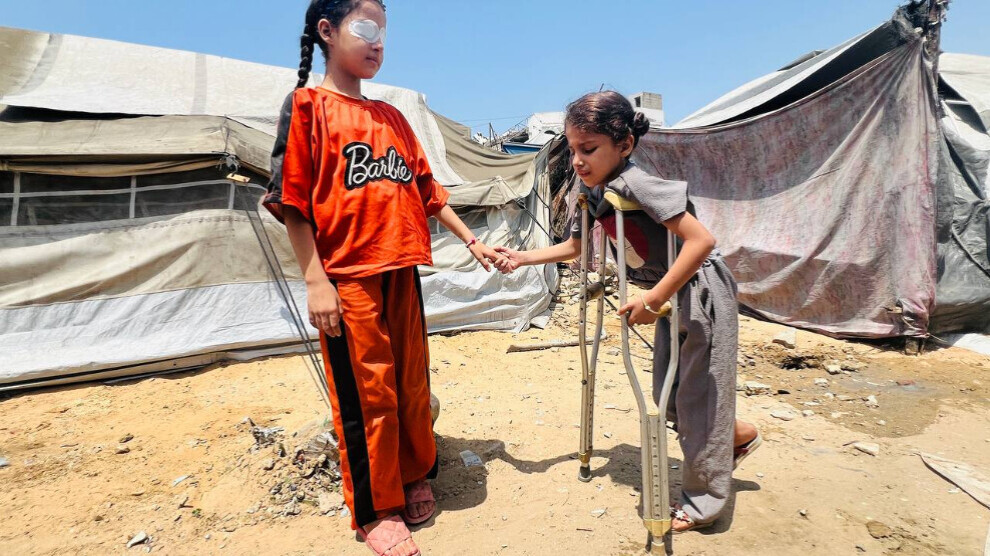Two sisters endure loss and disability amid war in Gaza
Maria and Ansam Rayhan, two young sisters scarred by loss and disability, embody the deep human tragedy of Gaza’s war and its devastating toll on children and families.

NAGHAM KARAJEH
Gaza – In a remote corner of northwest Gaza City, the fragile steps of 10-year-old Maria Rayhan and her eight-year-old sister Ansam stumble across the dusty floor of a dilapidated tent, their only refuge after an Israeli airstrike upended their lives. The strike was not merely a military assault but the obliteration of their entire family— severing bonds of blood and love, and leaving the two sisters adrift in a maze of grief and despair.
In Jabalia refugee camp in northern Gaza, where the family once lived in an old apartment building, their sense of security was shattered when Israeli forces issued evacuation threats, forcing them to flee temporarily in fear of an imminent strike.
Family shattered, childhood lost
Tears filled the eyes of 10-year-old Maria Rayhan as she recalled the terrifying moments of displacement. “We heard the sound of horror approaching. The army said they would bomb, so we left everything behind—my mother, father, and siblings… We never imagined we would never return,” she said.
But events took a cruel turn. Residents were later notified that their building would not be targeted, prompting families to return home, believing the danger had passed. Soon after, destroyed those fragile hopes, killing 20 members of Maria and Ansam’s extended family, including their parents and siblings.
Maria, barely ten years old, carries the heavy burden of partial blindness. The attack obliterated her right eye, while her left allows her to see only faint shadows. “I can only see silhouettes, and even those are blurry. I dream of seeing my sister again, and of continuing my studies to become a doctor like the one treating me,” she said.
Despite her suffering, Maria embodies both pain and resilience. Yet her life is marked by daily struggles that have grown far more difficult since her injury. Even the simplest tasks—such as going to the bathroom or eating a meal—are now impossible without constant help from her uncle or younger sister.
‘I dream of running again’
On the other side of this tragedy is Ansam Rayhan, who sustained a serious injury to her left leg. She underwent surgery to have a metal plate inserted into the bone—a term unfamiliar to her young ears, but one that now means she must rely on crutches to walk.
With eyes full of sorrow, Ansam said: “I used to play and run in the camp like any other child. Now I depend on crutches. I dream of running again with my friend. I just want my old life back.”
Their story is just one among countless others. Since the start of the war on October 7, 2023, the death toll in Gaza has reached catastrophic levels, with more than 61,400 Palestinians killed—including 15,600 children—and over 153,000 injured, according to the Palestinian Ministry of Health and United Nations reports.
Civilians account for nearly 80% of the fatalities, with hundreds more dying from starvation and lack of medical care, as only 14% of the required humanitarian aid has been allowed into the enclave. The destruction has devastated Gaza’s infrastructure, leaving essential services in ruins, including the closure of 352 schools and the loss of education for thousands of students. These figures underscore the magnitude of the humanitarian catastrophe, with children paying the heaviest toll.
True face of Gaza’s humanitarian catastrophe
Maria and Ansam are not just two victims among thousands—they embody the human face of Gaza’s humanitarian catastrophe. Daily struggles mix with extreme challenges following the destruction of infrastructure and essential services. According to the United Nations, more than 1.4 million internally displaced people in Gaza live in dire conditions in temporary shelters, with most families surviving in tents without access to water, electricity, or adequate healthcare.
In their small tent, which offers little more than protection from the sun and humidity, Maria tries to adapt to her new reality. “I rely on my sister Ansam when I feel thirsty or hungry. She is my eyes now, she is my hands,” the young girl whispers, unable to leave the tent without assistance. Meanwhile, Ansam speaks of their dreams despite the pain: “We just hope the war ends so we can return home, go back to school, play, and live like other children.”
Despite everything, Maria clings to a simple, persistent hope: to regain her sight. Gaza’s medical facilities lack the resources to perform the surgeries that could restore part of her vision. Her only real hope lies in traveling abroad for treatment—a near-impossible prospect amid the blockade and restricted permits.
Resilience amid pain and devastation
Ansam, with the honesty and innocence of childhood, says: “I want to run, play, return to school, and live like any other child my age.” Their story reflects the suffering of thousands of children whose childhoods have been stolen by a merciless conflict—but it also showcases their resilience and determination to endure amid devastation.
Under these conditions, the international community and humanitarian organizations must step up efforts to provide urgent medical, psychological, and humanitarian support to children facing lives on the brink of despair.
Ultimately, Maria and Ansam remain symbols of lost innocence and fragile hope, their small voices trembling between sorrow and aspiration, crying out for a better future where Gaza’s children can experience a life free from war and uncertainty.
